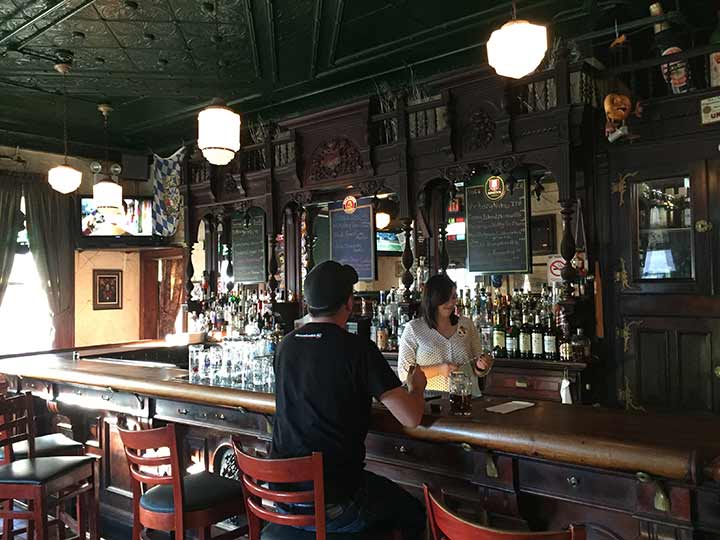
HARD to believe but it’s been since October 2017 since I was in Killmeyer’s, on Staten Island’s south shore, when I wrapped up a Forgotten NY tour there. This vintage German-style beer garden at 4254 Arthur Kill Road at Sharrotts Road was built by Nicholas Killmeyer and used initially as a grocery and residence by John Batchelor in 1845. By the 1880s, an addition was built and it became a roadhouse and tavern called Killmeyer’s Union Hotel. Now known as Killmeyer’s Old Bavaria Inn, it boasts its original bar and pressed tin ceiling, a menu full of sauerbraten, braunschweiger and other sausage treats, and dozens of brands of German beer. Oompah and pop bands play on Sunday afternoons and rock bands play the beer garden in the back on summer evenings.
The gorgeous, intricate woodworked bar, built in 1890, is reason enough to visit although there’s a wide beer selection and highly-rated German cuisine.
In 1854 Balthazar Kreischer was building a brick factory in what is now known as Charleston, Staten Island (Richmond County was then independent from NYC), motivated by clay ground in the area (Clay Pond Park State Preserve is nearby). Kreischer constructed a small company town in this remote corner of Staten Island centered around Arthur Kill Road and Kreischer and Androvette Streets. The brick works employed almost 150 and produced 20,000 bricks per day. Kreischerville, as the town was known, was entirely self-contained, with a hotel (still standing at Androvette and Kreischer Streets, now a Knights of Columbus), church, grocery store and inn. The factory closed in 1927. In the aftermath of World War I, many German-sounding names were purged from New York City directories, and so Kreischerville became known as “Charleston.”
There’s an Astoria Kreischer connection. Many of the yellow brick buildings constructed by developer Gustave X. Mathews on the streets of Astoria, Maspeth and Ridgewood used brick from Kreischer kilns, and in addition, one of Kreischer’s daughters married one of Henry Steinway’s sons; the Steinways put Astroia on the map with the piano factory that still runs today. Mathews, however, wasn’t Kreischer’s only client: builders and architects such as McKim, Mead & White and Ernest Flagg (whose own estate is in Todt Hill), Carrere and Hastings and other still well-known names appear in a 1902 Kreischer catalog.
Hopefully, I’ll be back in Killmeyer’s soon.
As always, “comment…as you see fit.” I earn a small payment when you click on any ad on the site. Take a look at the new JOBS link in the red toolbar at the top of the page on the desktop version, as I also get a small payment when you view a job via that link.
7/18/24


3 comments
Urban legend claims that the Hartford suburb of Berlin is pronounced “BURL-in” because of anti-German sentiment during World War I. As a full name change would have been too much trouble town officials declared that it was to be pronounced this way rather than in the German manner. In reality, the current pronunciation goes back to the 1800’s.
I’m betting that bar is old enough to have had no bar stools at one time.In the old days you “Bellied up to the bar”,
no stools.Im guessing that bar stools came in around the 1920s.What if McSorleys put in bar stools?
It reminds me of the long-gone Flessel’s in College Point.